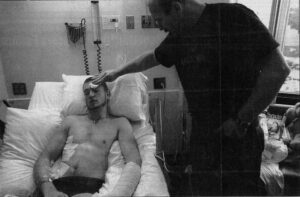
Before classes began at Thurston High School in Springfield, Oregon, on May 21, 1998, between 100 and 200 students were milling about in the cafeteria, including 17-year-old student Jacob Russell Ryker, who was sitting at a table with friends. As Jacob stood to leave the table, a 15-year-old Thurston High student entered the cafeteria and opened fire.
Jacob later said he thought the gunfire was fire crackers, but as he processed what was happening, he pushed his girlfriend onto a nearby table before falling to the ground; though he didn’t yet know it, he had been shot in the chest.
Chaos erupted as students fled, trying to escape or hide as the assailant continued to shoot — one 17-year-old was struck and killed.
From the floor, Jacob said later that he saw the assailant point a rifle at the head of a female student. The assailant pulled the trigger, but the gun did not fire.
As the assailant attempted to reload his weapon, Jacob got off the floor and ran 20 feet toward the assailant. He tripped and fell, but immediately returned to his feet and charged the assailant. He took the boy to the floor, causing him to drop the rifle. They struggled on the floor and other students joined in to assist Jacob, including his younger brother.
The assailant reached for a 9 mm, semi-automatic pistol in his waistband. Jacob grasped the gun with his left hand. The boy attempted to point it at Jacob’s face, but Jacob pushed the barrel away. Someone nearby yelled, “gun!” The pistol fired, shooting Jacob through the top knuckle of his left index finger. Jacob and the other students continued to wrestle with the gunman before a teacher arrived and pulled Jacob off the assailant. At this point, Jacob realized that he had been shot twice.
Police arrived and took the assailant into custody. All told, the boy had brought to school a sawed-off, semiautomatic .22-caliber rifle, two semiautomatic handguns, a knife with a 6-inch blade, a pocket knife, and 1,177 rounds of ammunition. He had shot two students outside the school prior to entering the cafeteria – killing one and injuring the other. He had also shot and killed his parents at home. Dozens of students were injured by gunfire, in addition to the two students who were killed.
Following the shooting, Jacob was hospitalized for four days for treatment of his injuries, which included a gunshot wound to his chest that caused significant blood loss and resulted in a fractured rib. The second gunshot wound fractured his left index finger, which required surgery. Jacob spent months in physical therapy healing from his injuries following the rescue.
The Hero Fund awarded Jacob the Carnegie Medal, as well as a $3,500 financial grant.
Additionally, according to a San Jose Mercury News report on Sept. 12, 1998, Jacob, a Boy Scout, received the organization’s highest honor, the Honor Medal with Crossed Palms. The award, which was established in 1938, is reserved for the rare Scout who puts his life at extreme risk while trying to save another’s life, demonstrating unusual heroism and extraordinary skill. The medal is the organization’s second most prestigious medal.
After graduation Jacob enlisted in the U.S. Marine Corps. Three years after the shooting, he and his girlfriend – the one he threw onto a table that day – married and they raised two children. They divorced in 2017.
“We went from sharing bullets to sharing kids,’’ Jen Ryker said in a 2018 Oregonian article.
The assailant pled guilty to four counts of murder and 26 counts of attempted murder. He was sentenced to 111 years in prison without the possibility of parole.
— Colin Cavada, Outreach assistant

